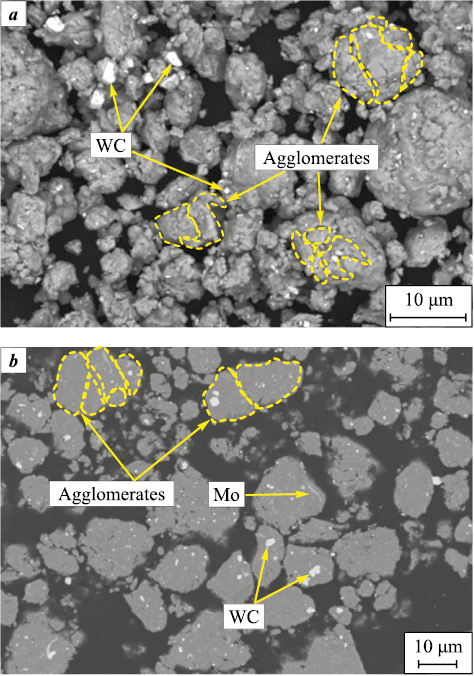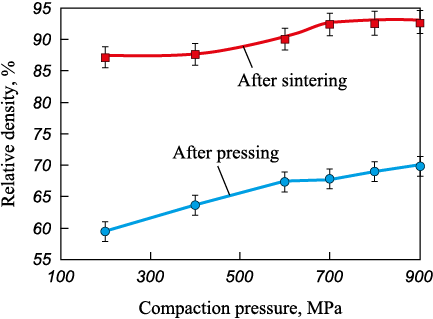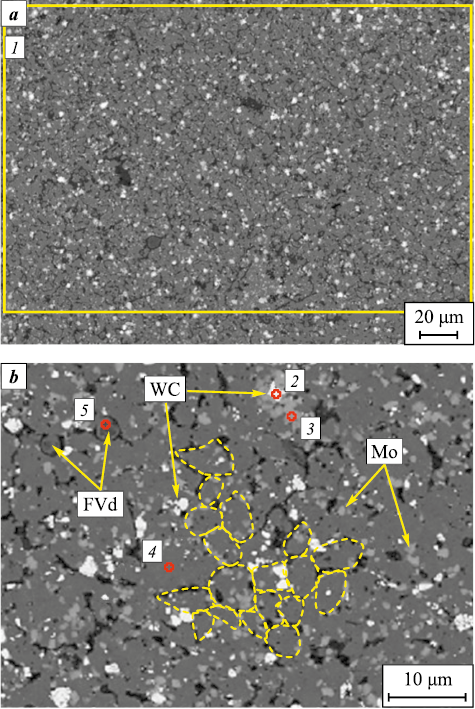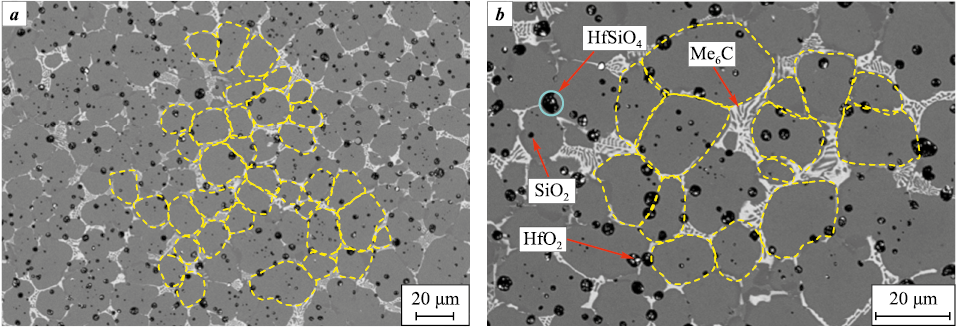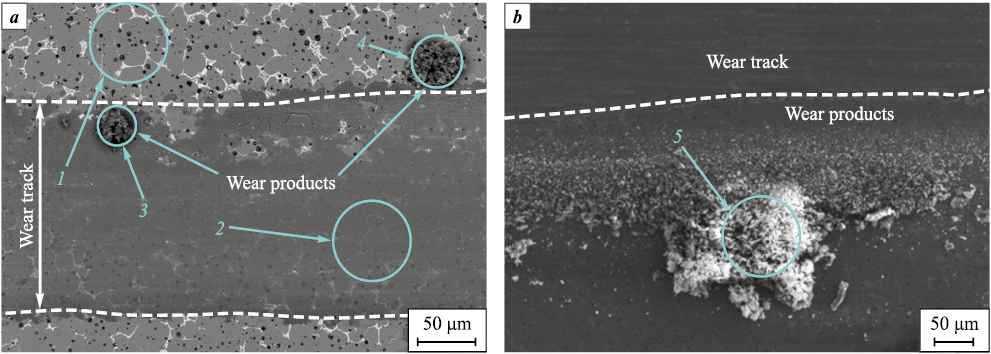Scroll to:
Dispersion strengthening of powder high-speed steel R6M5K5 with particles of SHS ceramics MoSi2–MoB–HfB2
https://doi.org/10.17073/1997-308X-2024-4-45-54
Abstract
The possibility of dispersion strengthening of powder high-speed steel R6M5K5 with MoSi2–MoB–HfB2 heterophase ceramics particles was investigated. A mechanically alloyed powder mixture with an average particle size of d = 10 µm was used as the base material; the ceramic powder additive (d = 5 µm), obtained by the SHS method, was also used. Mixing was carried out in a high planetary ball mill. As a result, powder mixture particles with sizes of 2–25 µm were obtained, close to spherical in shape, with larger particles being agglomerates. Cold pressing and sintering were performed, achieving a density of up to 92.7 % and a hardness of 62 HRA, as well as hot pressing with a density of 97.2 % and a hardness of 65 HRC. The hot-pressed billet had a bending strength of 1141 MPa and a compressive strength of 2157 MPa. The prospects of using heterophase ceramics as a strengthening additive was shown, which contributes to lowering the temperature of the liquid phase formation and creates a pronounced heterogeneous microstructure, similar to the microstructure of metallic glass materials. The matrix is a solid solution based on iron (with an average grain size of 14–34 µm) with a network of eutectic carbide Me6C and ceramic additive inclusions in the form of HfO2 , SiO2 , and HfSiO4 compounds. This provided a twofold reduction in wear during tribological tests against a counterbody made of VK6 hard alloy. The obtained composite material, demonstrating high red hardness, may find application in the production of wear-resistant products operating at temperatures up to 630 °C.
For citations:
Akhmetov A.S., Mukanov S.K., Samoshina M.E., Lopatin V.Yu., Eremeeva Zh.V. Dispersion strengthening of powder high-speed steel R6M5K5 with particles of SHS ceramics MoSi2–MoB–HfB2. Powder Metallurgy аnd Functional Coatings (Izvestiya Vuzov. Poroshkovaya Metallurgiya i Funktsional'nye Pokrytiya). 2024;18(4):45-54. https://doi.org/10.17073/1997-308X-2024-4-45-54
Introduction
Effective combinations of type and content of additives for strengthening powder high-speed steel (HSS) by introducing dispersed hard particles have been widely studied. Generally [1], when selecting strengthening additives, important criteria include their stability at the operating temperatures of the material being strengthened and minimal solubility in the matrix. Carbides such as NbC, TiC, VC, etc. [2–7], and nitrides like VN [8], meet these requirements for HSS. However, compounds that actively interact with the matrix can also be used as dispersed additives. For example, studies [9; 10] investigated the effect of adding boron carbide (B4C) on the properties of M3/2 powder steel (analogous to 10R6M5), consolidated by hot pressing. It was found that dispersion strengthening led to an increase in hardness up to 85 HRA, with B4C particles interacting with the matrix. At optimal concentrations, such an additive can ensure high density at relatively low sintering temperatures (t = 1150÷1190 °C) due to the interaction of both boron and carbon with the matrix. As a result, these characteristics significantly enhance the physical and mechanical properties of the material [10].
The consolidation of powder high-speed steel with strengthening additives is often performed by pressing and supersolidus sintering or hot pressing (HP), without resorting to hot isostatic pressing [2–11].
Another important aspect in the dispersion strengthening of powder HSS, in addition to the choice of additive and its content, is the method of mixing. Incorrect selection of the method and conditions can lead to particle segregation [12]. Usually, for mixing metal powders with dispersed additives, a planetary ball mill is used, which ensures not only high-quality mixing and uniform distribution of strengthening dispersed particles throughout the charge but also additional grinding of both the strengthening and base powder particles [13]. As a result, with a proper selection of the mixing mode in the planetary ball mill, a fine-grained structure of the material can be obtained, enhancing its physical and mechanical properties. High dispersion of the powder mixture particles can lead to activated sintering [14]. This also allows for maintaining a fine-grained structure by achieving high density with shorter sintering times, preventing grain growth due to prolonged holding.
The heterophase ceramic MoSi2–MoB–HfB2 , produced using self-propagating high-temperature synthesis (SHS), is of interest as a strengthening additive due to its high hardness (19.5 GPa) and heat resistance, particularly its resistance to oxidation at elevated temperatures across a wide range [15; 16]. The boron in the ceramic composition can help form a liquid phase at relatively low temperatures and activate the sintering process [10; 17].
Such complex compounds are rarely used as strengthening additives, making the study of their effect on the physical and mechanical properties and microstructure of HSS a pertinent task.
The aim of this work was to produce consolidated samples from a powder mixture of high-speed steel with the addition of heterophase ceramic MoSi2–MoB–HfB2 and to study their properties to identify promising areas of application for this material.
Materials and methods
The mechanically alloyed powder mixture of HSS grade R6M5K5 was used as the base material, with the following composition by mass percentage:
W . . . . . . . . . . . . . . . . 6.0
Mo . . . . . . . . . . . . . . . 5.0
Co . . . . . . . . . . . . . . . 5.0
Cr . . . . . . . . . . . . . . . . 4.0
V . . . . . . . . . . . . . . . . 2.0
C . . . . . . . . . . . . . . . . 0.9
Fe . . . . . . . . . . . . . . . Rest.
This mixture was obtained by milling in a Planetary ball mill “Activator – 4M” (Russia) at a drum rotation speed of 800 rpm, with a ball-to-powder ratio of 10:1 and a milling time of 30 min. The characteristics of the initial powder components used to produce this mixture are presented in Table 1.
Table 1. Characteristics of the initial powder components
|
The size range of the main fraction of the mechanically alloyed powder mixture was 3–20 µm, with an average particle diameter of 10 µm and D50 = 9 µm. The mixture consists of solid solutions based on Fe, W, and Mo, as well as WC carbide. The ceramic powder additive had a composition of 60 % (90 % MoSi2–10 % MoB) + 40 % HfB2 , with an average particle size of 5 µm. The method of its production is described in [15].
The powder steel was mixed with 3 vol. % of the strengthening additive and processed in the Planetary ball mill “Activator – 4M” at a drum rotation speed of 800 rpm, a ball-to-powder ratio of 10:1, and processing times of 15, 30, and 45 min.
The microstructure of the samples was examined using a scanning electron microscope (SEM) S-3400N (Hitachi, Japan) equipped with an energy-dispersive X-ray spectrometer (EDS) NORAN System 7 X-ray Microanalysis System (Thermo Scientific, USA).
X-ray diffraction phase analysis (XRD) of the samples was performed on a D2 PHASER diffractometer (Bruker AXS GmbH, Germany) using CuKα radiation (1.5418 Å).
Particle size distribution was assessed using an ANALYSETTE 22 MicroTec plus (Fritsch GmbH, Germany). The flowability and bulk density of the powder mixture were determined according to GOST 20899-98 and GOST 19440-94, respectively. Additionally, the compressibility during cold pressing and the change in density after sintering were investigated.
Cold pressing of the obtained mixture with and without the ceramic additive was carried out in a steel mold with an inner diameter of 12 mm at pressures ranging from 200 to 900 MPa, and the sintering of the billets was conducted at 1200 °C for 60 min. Hot pressing was performed in a graphite mold with an inner diameter of 20 mm in a Direct Hot Pressing DSP-515 SA press (Dr. Fritsch Sondermaschinen GmbH, Germany) under vacuum at 1000 °C and 50 MPa. The heating and cooling rates were 50 °C/min, with an isothermal holding time of 3 min. The mass of the charge during pressing was calculated to ensure that the height of the pore-free billets was 0.5 times the diameter. Heat treatment (HT) of the obtained hot-pressed billets was carried out under the following conditions: annealing at 800 °C, quenching in oil from 1210 °C, and double tempering at 560 °C [18].
The compressive and flexural strength were evaluated using an LF-100KN testing machine (Walter + Bai, Switzerland). Hardness after hot pressing, heat treatment, and annealing at 630 °C for 4 h (red hardness) was measured using a TR5006 hardness tester (Tochpribor, Russia).
Comparative tribological tests were conducted at room temperature using a Tribometer friction machine (CSM Instruments, Switzerland) in accordance with ASTM G 99-17 and DIN 50324. The tests were performed in a reciprocating motion mode with a “pin-on-disc” configuration. A ball made of WC–Co hard alloy (VK6) was used as the counterbody. The test conditions were as follows: linear speed – 10 cm/s, applied load – 2 N, track length – 4 mm, and total running distance – 10,000 cycles. The profiles of the wear tracks were studied using a WYKO NT 1100 optical profilometer (Veeco, USA).
Results and discussion
After processing (mixing) in the planetary ball mill for 15, 30 and 45 min, the technological properties of each powder mixture were determined: flowability, bulk density, and particle size distribution. The results are presented in Table 2.
Table 2. Technological properties of the HSS powder mixture
|
The obtained powder mixtures did not exhibit flowability when tested according to GOST 20899-98. Minor variations in bulk density values are associated with differences in particle sizes. The lack of flowability and low bulk density are due to the high dispersion of the powder mixture (average particle size 10–16 µm). Changes in particle size distribution are explained by the different milling durations: 15, 30 and 45 min. In the latter case, the particles tend to agglomerate. Further studies were conducted on the powder mixture processed in the planetary ball mill for 30 min, which is optimal for achieving a dispersed particle size distribution.
Figure 1 shows SEM images of the morphology of the powder mixture particles and their microstructure on a cross-section. It can be seen that the powder mixture particles range in size from 2 to 25 µm, with a near-spherical shape, and larger particles are agglomerates. The images were obtained in backscattered electron detection mode, which highlights heavy alloying elements (tungsten and molybdenum) by contrast, distributed both on the surfaces and within the iron particles.
Fig. 1. SEM images of the morphology of HSS powder mixture particles (a) |
The presence of the introduced ceramic is detected only through general EDS analysis of the observed areas, indicating a high uniformity of the dispersion of the additive within the powder mixture, without the formation of separate agglomerates.
Figure 2 shows the dependence of the relative density of the billets on the compaction pressure after pressing and sintering. The dependencies show that during cold pressing, the powder mixtures are compacted to achieve a relative density of up to 69.8 % at a pressure of 900 MPa. After sintering, the density increases to 92.7 %. The highest hardness (62.0 ± 1.0 HRA) is observed in the densest sintered billets, pressed at P = 900 MPa. The high level of compressibility during cold pressing is provided by the iron-based matrix powder.
Fig. 2. Dependence of relative density of billets |
The significant increase in density during sintering indicates an intense process at 1200 °C. This is due to the high initial dispersion of the powder mixture, which provides an increased specific surface area and promotes the activation of sintering. The presence of boron lowers the temperature of liquid phase formation in the steel, further activating the sintering process [10; 17]. This may result in the formation of some amount of liquid phase.
Figure 3 shows SEM images of the microstructure of the sintered sample of R6M5K5 steel with ceramic additive, pressed at P = 900 MPa. The microstructure of the sintered billet is quite homogeneous and porous, with alloying elements not forming carbide compounds Me6C and MeC, which ensure the red hardness of HSS. The effect of the ceramic additive on the microstructure images and EDS analysis results is difficult to assess. In Fig. 3, b, grains of the matrix with a size of 3–8 µm can be distinguished. The general elemental EDS analysis (integral area in Fig. 3, a) shows the presence of Hf and Si, which are part of the ceramic but not included in the composition of R6M5K5 steel itself (Table 3). This indicates significant dissolution of the ceramic additive in the steel matrix.
Fig. 3. SEM images of the microstructure of the sintered sample
Table 3. Results of general and EDS analyses of microstructural components
| ||||||||||||||||||||||||||||||||||||||||||||||||||||||||||||||||||||||||||||
After hot pressing the powder mixture, the obtained billet had a hardness of 64.0 ± 0.3 HRC with a relative density of 97.2 %, and after heat treatment, the hardness changed slightly to 64.7 ± 0.2 HRC. The high hardness of the hot-pressed billet is due to the low temperature of hot pressing, which preserves a finer grain structure. During prolonged holding during annealing and austenitization at high temperatures, inevitable grain growth occurs. The increase in hardness after heat treatment is largely due to the formation of a carbide network during quenching and secondary carbides during tempering [19].
Figure 4 shows SEM images of the microstructure of the hot-pressed billet after heat treatment. As seen from the data, carbide Me6C with characteristic morphology is distributed along the grain boundaries, which is more typical for cast HSS [18; 20]. This may indicate the formation of a significant amount of liquid phase due to the melting of eutectic as a result of the influence of boron with the precipitation of eutectic carbide Me6C, necessitating quenching at lower temperatures [17; 19]. In the matrix, represented by a solid solution based on iron, alloying elements are dissolved. After hot pressing followed by heat treatment, the introduced ceramic particles are fixed in the microstructure (marked in Fig. 4, b according to the presumed phases). The average grain size is 14–34 µm, and the size of the ceramic particles is 2–4 µm. Secondary carbide MeC is not detected, and vanadium, according to EDS results (Table 4), is contained in the matrix and Me6C carbide. Secondary carbide MeC is not observed in the studied microstructure areas and XRD results (Table 5), as evidenced by the slight increase in hardness after heat treatment.
Fig. 4. SEM images of the microstructure of the hot-pressed biller after heat treatment
Table 4. Results of EDS analysis of microstructural components
Table 5. XRD results of the hot-pressed R6M5K5 billet
| ||||||||||||||||||||||||||||||||||||||||||||||||||||||||||||||||||||||||||||||||||||||||||||||||||||||||||||||
According to XRD data, the following phases are identified: α-Fe (matrix), carbide Me6C (W3Fe3C/Mo3Fe3C), as well as HfO2 and HfSiO4 , which is consistent with the microstructure analysis results. Ceramic inclusions (Fig. 5) may represent hafnium silicate, which could form during the hot-pressing process or subsequent heat treatment [15; 21]. White particles in the structure of the ceramic additive (see Fig. 4, Table 4) in some areas are similar in composition to HfO2, indicating incomplete interaction of HfO2 with SiO2 , which forms HfSiO4 [21]. Accordingly, the black areas are similar in composition to SiO2 .
Fig. 5. Dependence of friction coefficient on running distance (a) and 2D profiles of wear tracks (b) |
The strength characteristics of the hot-pressed billets were studied: the bending and compressive strength values were 1141 ± 50 and 2157 ± 42 MPa, respectively. Additionally, the red hardness of the hot-pressed samples was determined by annealing in air for 4 h at 630 °C. The hardness after annealing was 59.5 ± 0.8 HRC, meeting the requirements of GOST 19265-73.
Figure 5 shows the effect of the ceramic additive on the friction coefficient dependence on the running distance and the 2D profile of the wear track of hot-pressed powder high-speed steel R6M5K5 billets. It was found that they have a consistently low friction coefficient (0.20–0.22) when sliding against a VK6 alloy ball. The specific wear values calculated from the 2D profiles of the wear tracks were 5.40·10\(^–\)6 and 2.56·10\(^–\)6 mm3/(N·m) for the R6М5К5 and Р6М5К5 + ceramic billets, respectively. Thus, the ceramic additive doubles the wear resistance of R6M5K5 steel (see Table 5). This is primarily due to the high hardness (64.0 ± 0.3 HRC) of the sample, owing to the formation of a carbide network and hard particles of SiO2 and HfO2 . However, the specific wear of the counterbody (Table 6) is twice as high when testing R6M5K5 with the ceramic additive.
Table 6. Results of tribological tests
| |||||||||||||||||||||||
According to [22], the increase in the actual contact area of the tribopair is accompanied by an increase in the friction coefficient. However, when sliding the ball on the R6M5K5 sample with the ceramic additive, this parameter did not change. The wear track of the R6M5K5 billet with the ceramic additive was studied using SEM (Fig. 6). At its edge, corresponding products in the form of flake-like agglomerates are present. According to EDS data (Table 7), they represent a mixture of oxidized counterbody and steel particles. Also, an adhered layer of oxidized wear products from the sample and counterbody was found in the wear track area. The pronounced heterogeneous structure with ceramic inclusions is similar to the structure of powder metallic glass materials [23].
Fig. 6. SEM images of the wear track of the hot-pressed sample (a) and wear products (b)
Table 7. Results of EDS analysis of wear track components
| ||||||||||||||||||||||||||||||||||||||||||||||||||||||||||||||||||||||||||||
During wear, HfO2 , SiO2 and HfSiO4 particles may contribute to its reduction [24]. The formed carbide structure is more preferable from the wear resistance perspective compared to dispersed carbides [25]. It can be assumed that the obtained composite material, demonstrating high red hardness, can also find application in the production of wear-resistant products operating at temperatures up to 630 °C.
Conclusions
1. Sintered and hot-pressed billets of HSS grade R6M5K5 with a 3 % addition of heterophase ceramic MoSi2–MoB–HfB2 were obtained, achieving relative densities of up to 92.7 % and 97.2 %, respectively. The hardness of the sintered billet was 62.0 HRA, while the hot-pressed billet reached 64.7 HRC. Both billets exhibited a bending strength of 1141 MPa and a compressive strength of 2157 MPa.
2. It was established that the hot-pressed billet is characterized by a pronounced heterogeneous microstructure, similar to that of metallic glass materials.
3. Tribological tests showed that the addition of the ceramic MoSi2–MoB–HfB2 to the hot-pressed R6M5K5 high-speed steel billet resulted in more than a twofold increase in wear resistance.
4. A method for further improvement of the physical and mechanical properties is proposed by introducing a smaller amount of boron-containing ceramic additive and performing quenching at lower temperatures.
References
1. Kostikov V.I., Eremeeva Zh.V. Technology of composite materials: Textbook. Moscow: Vologda: Infra-Inzhenerija, 2021. 484 p. (In Russ.).
2. Matula G., Dobrzański L.A., Herranz G., Várez A., Levenfeld B., Torralba J.M. Structure and properties of HS6-5-2 type HSS manufactured by different P/M methods. Journal of Achievements in Materials and Manufacturing Engineering. 2007;24:71–74.
3. Liu Z.Y., Khor K.A., Tor S.B. Mechanical alloying of TiC/M2 high speed steel composite powders and sintering investigation. Materials Science and Engineering: A. 2001; 311:31–21. https://doi.org/10.1016/S0921-5093(01)00929-7
4. Herranz G., Matul G., Alonso R., Sánchez I., Rogriguez G. Metal injection moulding of carbides reinforced M2 HSS. Proceedings of the Euro International Powder Metallurgy Congress and Exhibition. 2009;2:99–104.
5. Herranz G., Romero A., de Castro V., Rodríguez G.P. Processing of AISI M2 high speed steel reinforced with vanadium carbide by solar sintering. Materials & Design. 2014;54:934–946. https://doi.org/10.1016/j.matdes.2013.09.027
6. Hadian A., Gorjan L., Clemens F.J. Thermoplastic processing and debinding behavior of NbC-M2 high speed steel cemented carbide. Journal of Materials Processing Technology. 2019;263:91–100. https://doi.org/10.1016/j.jmatprotec.2018.08.006
7. Madej M. Phase reactions during sintering of M3/2 based composites with WC additions. Archives of Metallurgy and Materials. 2013;58(3):703–708. https://doi.org/10.2478/amm-2013-0058
8. Chen N., Luo R., Xiong H., Li Z. Dense M2 high speed steel containing core-shell MC carbonitrides using high-energy ball milled M2/VN composite powders. Materials Science and Engineering: A. 2020;771:138628. https://doi.org/10.1016/j.msea.2019.138628
9. Thavale V.T., Dhokey N.B. Wear behavior and machinability of hot pressed sintering of B4C reinforced M3/2 HSS composite. Materials Today: Proceedings. 2021;44(6):4891–4897. https://doi.org/10.1016/j.matpr.2020.11.710
10. Zhang F., Luo P., Ouyang Q., He Q., Hu M., Li S. microstructure and mechanical properties of B4C-blended M3:2 high-speed steel powders consolidated by sintering and heat treatment. Journal of Materials Engineering and Performance. 2019;28:6145–6156. https://doi.org/10.1007/s11665-019-04347-x
11. German R.M. Supersolidus liquid-phase sintering of prealloyed powders. Metallurgical and Materials Transactions A. 1997;28(7):1553–1567. https://doi.org/10.1007/s11661-997-0217-0
12. Lapshin O.V., Boldyreva E.V., Boldyrev V.V. Role of mixing and milling in mechanochemical synthesis (Review). Russian Journal of Inorganic Chemistry. 2021;66(3):433–453. https://doi.org/10.1134/S0036023621030116
13. Avvakumov E.G. Mechanical methods for activating chemical processes. 3rd ed. Moscow: LENAND, 2022. 306 p. (In Russ.).
14. Antsiferov V.N., Antsiferova I.V. Features of sintering using nanosized carbide powders (scientific review). Vestnik PNIPU. Mashinostroenie, materialovedenie. 2015;2: 66–76. (In Russ.).
15. Potanin A.Yu., Vorotilo S., Pogozhev Yu.S., Rupasov S.I., Lobova T.A., Levashov E.A. Influence of mechanical activation of reactive mixtures on the microstructure and properties of SHS-ceramics MoSi2–HfB2–MoB. Ceramics International. 2019;45(16):20354–20361. https://doi.org/10.1016/j.ceramint.2019.07.009
16. Potanin A.Yu., Pogozhev Yu.S., Levashov E.A., Novikov A.V., Shvindina N.V., Sviridova T.A. Kinetics and oxidation mechanism of MoSi2–MoB ceramics in the 600–1200°C temperature range. Ceramics International. 2017;43(13):10478–10486. https://doi.org/10.1016/j.ceramint.2017.05.093
17. Bendereva E.D., Vylkanov S.T. Activating effect of boron microadditions on sintering of powder alloy based on iron. Metallurgist. 2012;55(9-10):761–768. https://doi.org/10.1007/s11015-012-9500-4
18. Geller Ju.A. Tool steels. 4th ed. Moscow: Metallurgiya, 1975. 584 p. (In Russ.).
19. Chaus A.S. Structural and phase changes in carbides of the high-speed steel upon heat treatment. The Physics of Metals and Metallography. 2016;117:684–692. https://doi.org/10.1134/S0031918X16070048
20. Ha T. K., Yang E. I., Jung J. Y., Park S. W. Effect of alloying elements and homogenization treatment on carbide formation behavior in M2 high-speed steels. Korean Journal of Metals and Materials. 2010;48(7):589–597. https://doi.org/10.3365/KJMM.2010.48.07.589
21. Potanin A.Yu., Vorotilo S., Pogozhev Yu.S., Rupasov S.I., Loginov P.A., Shvyndina N.V., Sviridova T.A., Levashov E.A. High-temperature oxidation and plasma torch testing of MoSi2–HfB2–MoB ceramics with single-level and two-level structure. Corrosion Science. 2019;158:108074. https://doi.org/10.1016/j.corsci.2019.07.001
22. Kragel’skiy I.V. Friction and wear. 2nd ed. revised and updated. Moscow: Mashinostroenie, 1968. 480 p. (In Russ.).
23. Libenson G.A. Production of powder products: Textbook for technical schools. 2nd ed. revised and updated. Moscow: Metallurgiya, 1990. 240 p. (In Russ.).
24. Pereira N.F., Rubio C.J., dos Santos J.A., Houmard M., Câmara M., Rodrigues A. Drilling of nodular cast iron with a novel SiO2 coating deposited by sol-gel process in HSS drill. The International Journal of Advanced Manufacturing Technology. 2019;105:1–13. https://doi.org/10.1007/s00170-019-04429-z
25. Chaus A.S., Hudáková M. Wear resistance of high-speed steels and cutting performance of tool related to structural factors. Wear. 2009;267(5-8):1051–1055. https://doi.org/10.1016/j.wear.2008.12.101
About the Authors
A. S. AkhmetovRussian Federation
Amankeldy S. Akhmetov – Scientific Project Engineer, Department of Powder Metallurgy and Functional Coatings (PM&FC)
4 bld. 1 Leninskiy Prosp., Moscow 119049, Russia
S. K. Mukanov
Russian Federation
Samat K. Mukanov – Cand. Sci. (Eng.), Junior Research Scientist, Laboratory “In situ Diagnostics of Structural Transformations”, Scientific Educational Center of Self–Propagating High-Temperature Synthesis
4 bld. 1 Leninskiy Prosp., Moscow 119049, Russia
M. E. Samoshina
Russian Federation
Vladimir Yu. Lopatin – Cand. Sci. (Eng.), Associate Professor, Department of PM&FC
4 bld. 1 Leninskiy Prosp., Moscow 119049, Russia
V. Yu. Lopatin
Russian Federation
Marina E. Samoshina – Cand. Sci. (Eng.), Head of the Division of Academic Degrees, Academic Secretary of the Dissertation Board
4 bld. 1 Leninskiy Prosp., Moscow 119049, Russia
Zh. V. Eremeeva
Russian Federation
Zhanna V. Eremeeva – Dr. Sci. (Eng.), Professor, Department of PM&FC
4 bld. 1 Leninskiy Prosp., Moscow 119049, Russia
Review
For citations:
Akhmetov A.S., Mukanov S.K., Samoshina M.E., Lopatin V.Yu., Eremeeva Zh.V. Dispersion strengthening of powder high-speed steel R6M5K5 with particles of SHS ceramics MoSi2–MoB–HfB2. Powder Metallurgy аnd Functional Coatings (Izvestiya Vuzov. Poroshkovaya Metallurgiya i Funktsional'nye Pokrytiya). 2024;18(4):45-54. https://doi.org/10.17073/1997-308X-2024-4-45-54




